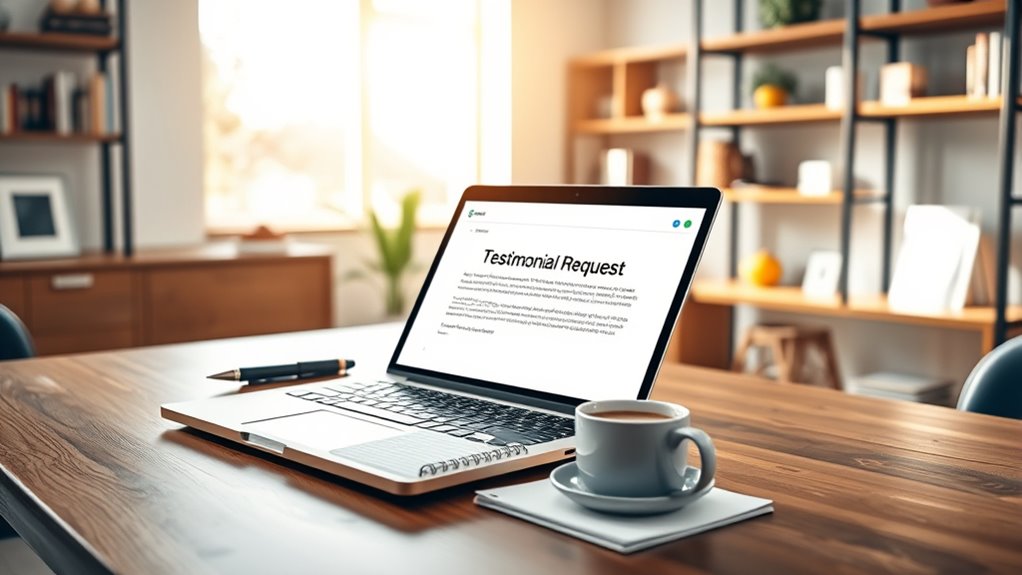To craft an effective testimonial request email, personalize your message by addressing customers by name and mentioning their specific experience. Start with gratitude, then clearly ask for their feedback, explaining how their testimonial can help others and improve your services. Keep the tone friendly and straightforward, including a simple link or instructions for sharing their review. Focusing on ease and sincerity will boost your chances of receiving great reviews—if you want to learn more, keep exploring these tips.
Key Takeaways
- Personalize your email by addressing the customer by name and referencing their specific purchase or experience.
- Clearly explain how their testimonial will help others and improve your services, emphasizing its value.
- Keep the request straightforward and specific, providing easy-to-follow instructions or a direct review link.
- Use a friendly, conversational tone to build rapport and make the customer comfortable sharing feedback.
- End with gratitude and your contact info, reinforcing appreciation and encouraging ongoing engagement.

Ever wondered how to effectively ask your customers for testimonials? The key lies in understanding that a well-crafted testimonial request can considerably boost your credibility and attract new clients. To make that happen, you need to focus on fostering genuine customer engagement. When customers feel appreciated and valued, they’re more inclined to share their positive experiences. But how do you encourage that kind of engagement through your email? The answer is simple: email personalization. Instead of sending a generic message, tailor each email to the recipient. Mention their name, reference their specific purchase or interaction, and show that you’ve taken the time to understand their unique experience. Personalization makes your request feel sincere, not like a mass blast, which increases the likelihood of a positive response.
Start your email by addressing the customer directly. Use their first name and express gratitude for their recent business. For example, “Hi [Name], I hope you’re enjoying your recent purchase.” This sets a warm, friendly tone and indicates that you value their individual experience. Then, briefly remind them of the product or service they used, which reinforces their connection to your brand. Next, clearly state your request in a straightforward manner. Instead of vague phrases like “We’d love to hear from you,” be specific: “Would you mind sharing a quick testimonial about your experience with us?” Keep your tone conversational and approachable, making it easy for them to say yes.
Start your email warmly by addressing the customer by name and expressing gratitude for their recent purchase.
To maximize customer engagement, explain why their testimonial matters. Let them know that their feedback not only helps you improve but also assists other potential customers in making informed decisions. When people understand the impact of their words, they’re more motivated to participate. You can also include a simple call-to-action, such as a direct link to a review form or an email reply. Make sure to provide guidance on how they can share their feedback most easily by including clear instructions or helpful tips. Keep the process as effortless as possible, because the easier you make it, the more likely they are to follow through.
Finally, close your email with an expression of appreciation, regardless of whether they agree to provide a testimonial. For example, “Thanks so much for your support—your feedback means a lot to us.” End with your name and contact info to add a personal touch. By focusing on customer engagement and email personalization, you create a genuine connection that encourages your customers to share their positive experiences. This approach not only garners better reviews but also builds a stronger relationship with your audience.
Frequently Asked Questions
When Is the Best Time to Request a Testimonial?
You should request a testimonial immediately after a positive interaction or successful delivery, as this timing considerations boost customer engagement. When customers are still excited or satisfied, they’re more likely to share genuine feedback. Avoid waiting too long, which can diminish enthusiasm. Reach out within a few days of their experience, ensuring their memory is fresh and their engagement remains high, increasing your chances of receiving compelling testimonials.
How Personalized Should the Testimonial Request Email Be?
Imagine you’re sitting at a cozy café, sipping coffee with a friend. Your testimonial request email should feel just as warm and personal. You need to use email personalization to address your customer by name, reference their specific experience, and show genuine appreciation. This level of customer engagement makes your message feel sincere, increasing the chances they’ll share an authentic testimonial. Keep it tailored, friendly, and relatable.
Should I Offer Incentives for Testimonials?
Offering customer incentives or testimonial rewards can boost response rates, but use them thoughtfully. You should consider providing small incentives, like discounts or freebies, to motivate customers without seeming pushy or biased. Just be transparent about your intentions, and guarantee the incentives encourage honest feedback. This approach makes customers feel appreciated and can lead to more genuine, compelling testimonials that strengthen your brand’s credibility.
How Do I Handle Negative Feedback in Testimonials?
Handling criticism or negative reviews can feel tough, but it’s an opportunity to show your professionalism. You should acknowledge negative feedback respectfully, thank the reviewer for their honesty, and address their concerns if possible. Respond promptly and privately if needed, demonstrating you value their input. This approach not only helps you manage negative reviews effectively but also shows potential customers your commitment to improvement and excellent service.
What Tone Is Most Effective in Testimonial Request Emails?
You should use a friendly, genuine tone in your testimonial request emails, combining customer gratitude with professionalism. This approach makes recipients feel appreciated and comfortable sharing their experiences. Keep your message warm and respectful, avoiding overly casual language, and focus on showing appreciation for their support. By maintaining this professional tone, you encourage honest, positive reviews while strengthening your relationship with your customers.
Conclusion
Now that you know how to craft compelling testimonial requests, it’s time to take action. Remember, a sincere, specific, and succinct message can make a significant difference. Keep your tone friendly, your ask clear, and your gratitude genuine. By mastering this method, you’ll motivate customers to share shining stories that strengthen your brand. So, start sending those savvy, sincere, and standout testimonials today — success is just a simple email away!









